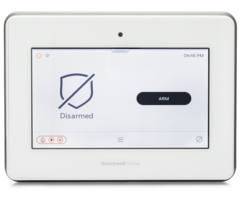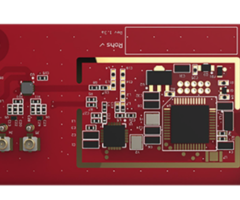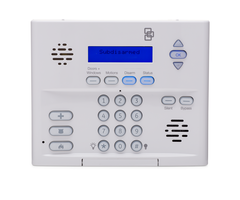How Do I Upgrade My Interlogix Simon XT to a Honeywell PROA7PLUS?
You can upgrade your Interlogix Simon XT to a Honeywell PROA7PLUS by installing a Honeywell Home PROTAKEOVER Module inside the PROA7PLUS Alarm Panel. By doing this, you can continue using most of your existing sensors with the PROA7PLUS System. Existing 319.5 MHz sensors will be supported.

The Interlogix Simon XT supports wireless 319.5 MHz sensors, including those from the Interlogix/GE and Qolsys lineups. After you install the PROTAKEOVER Module inside the PROA7PLUS, the system will be able to support one (1) of five (5) possible legacy sensor frequencies. One of the available options is for 319.5 MHz sensors, and there are a couple of important things to keep in mind when doing this.
First, only one legacy frequency can be used with the unit at any given time. There is a dial on the PROTAKEOVER that allows you to select the legacy frequency that will be supported. By setting the dial to 3, the PROA7PLUS will support legacy Qolsys and Interlogix/GE Sensors that operate at 319.5 MHz. No other legacy frequencies, such as 345 MHz or 433 MHz, can be supported by the PROA7PLUS when you do this. And since you can only have one (1) PROTAKEOVER unit installed inside a PROA7PLUS Alarm Panel, there is no other way to get the system to support other sensor frequencies. When upgrading from an Interlogix Simon XT, this isn't usually a big concern, as that panel only supports 319.5 MHz wireless sensors, and it's unlikely that you would be bringing over any other RF sensors that operate at another frequency. But if you were hoping to also use legacy sensors operating at a different frequency, then you won't be able to do that.
Second, certain sensor types, namely life-safety sensors, cannot be used with the PROTAKEOVER. This includes any smoke detectors, heat detectors, or carbon monoxide (CO) detection sensors. This limitation is an intentional design by Resideo, due to safety concerns. Additionally, most key fob devices are also incompatible with the module. Alarm Grid recommends checking out the PROTAKEOVER Compatibility Chart to make sure that any sensors you planned to use are compatible. If a sensor isn't listed on the chart, then it cannot be guaranteed to work. However, it has been proven that some sensors not listed on the chart will still work properly. For example, the Honeywell 5800MINI is a 345 MHz sensor that has been verified to work with the PROTAKEOVER Module when the unit is set to support those types of sensors, even though the 5800MINI is not listed on the PROTAKEOVER Compatibility Chart. Really, when the PROTAKEOVER has its dial set to 3, you should expect it to support any 319.5 MHz sensor that isn't a key fob or life-safety device. But still, any sensor not listed on the chart is not guaranteed to work.
If you need to get both a PROA7PLUS System and a PROTAKEOVER Module, then you should consider buying one of our bundled kits. Each kit below includes a PROA7PLUS Panel, a PROTAKEOVER Converter, and a Honeywell LT-CABLE for connecting the panel to the included transformer. You can also choose to get a kit with an added cellular communicator, which will provide an extra pathway when communicating with the Resideo AlarmNet servers and the central monitoring station. The PROA7PLUS already has a built-in WIFI card for this purpose, but an internet outage will take the panel completely offline if a cellular backup isn't added. By adding a compatible cellular communicator, you can make the PROA7PLUS into a dual-path system that will stay monitored even if one communication pathway goes down or becomes unavailable. You can choose between AT&T LTE and Verizon LTE for cellular communication. You should select whichever network provides more reliable service in your area. This decision has nothing to do with your personal cellular carrier, so check coverage maps and see which one is the better option for you. Keep in mind that you will need to get a monitoring plan that includes cellular service if you intend on setting up the system with a cellular communicator. More information about Alarm Grid monitoring plans can be found in this blog post.
PROA7PLUS RF Takeover Kits
| Kit Name | SKU | Communicator Type |
|---|---|---|
| Honeywell Home PROA7PLUSWLTAKE | PROA7PLUSWLTAKE | Built-in WIFI Communicator |
| Honeywell Home PROA7PLUSWLTAKEA | PROA7PLUSWLTAKEA | Built-in WIFI Communicator AT&T LTE Communicator |
| Honeywell Home PROA7PLUSWLTAKEV | PROA7PLUSWLTAKEV | Built-in WIFI Communicator Verizon LTE Communicator |
Complete the following steps to upgrade to a PROA7PLUS from an Interlogix Simon XT:
1. Install the PROTAKEOVER Module. If your PROA7PLUS System isn't already powered down, then start by dropping all power to the system. This will include unplugging the system's transformer and disconnecting its backup battery pack. You will need to take out the panel's bottom set screw and then take the panel off of its backplate in order to access the backup battery pack.
Included with the PROTAKEOVER Module is a new panel backplate for the PROA7PLUS. Using this new backplate is required, as it includes an integrated antenna that is used by the PROTAKEOVER Module. Without access to this antenna, the PROA7PLUS System will have almost no wireless range when communicating with legacy sensors. On the PROTAKEOVER Module, there are two (2) metal prongs. These metal prongs make direct contact with the inner backplate antenna when the panel is properly connected. If the panel was previously mounted on its stock backplate, then just dismount that old backplate and install the PROTAKEOVER backplate in the same spot.
With the PROA7PLUS Panel off the backplate, flip the system over, and have its backside facing you. This is the side opposite the panel's touchscreen controller. There should be a slot cover on the right-hand side. This cover will slide off to the right from the panel rather easily. Once the cover is off, carefully insert the PROTAKEOVER Module. Remember to set the dial to 3 so that 319.5 MHz sensors will be supported. You can tell that the module is installed properly because the set screw slot will be aligned with the corresponding slot in the panel plastic. Applying the set screw is optional, but it is recommended so that the unit stays as secure as possible.

Once you have finished, reapply the side cover, and then reapply power to the system. First, plug in the backup battery, then connect AC power when powering on. Powering up in this order is always strongly recommended. The battery can be plugged back into the connector port, and then the transformer can be plugged back into the outlet. Finally, mount the alarm panel on the new backplate that came with the PROTAKEOVER Module. You might also refer to the PROTAKEOVER Installation Guide for additional help if you are having trouble.
2. Enroll existing wireless sensors. Now it is time to enroll your existing wireless sensors with the PROA7PLUS. You can do this yourself if your PROA7PLUS System supports local end-user programming. But as of May 2021, local end-user programming is only supported in a beta release for the system, and it is not available to the general public. If your PROA7PLUS does not support local end-user programming, then you will need to get it upgraded so that it supports the feature, or you will need to have your alarm monitoring provider assist you in programming the system. For this FAQ, we will be covering the programming process as though you have local end-user programming and can program sensors yourself. But if you don't have end-user programming, then you should reach out to your monitoring provider for further assistance in setting up the system.
If you have local end-user programming, then you can program your existing 319.5 MHz sensors on your own. Begin from the main screen of the PROA7PLUS. Click the three horizontal bars menu button at the bottom-center of the screen. Then choose Tools. Then enter the Installer Code for the system. This code is 4112 by default. Next, select Programming, followed by Peripherals. Then click the plus (+) icon in the upper-right corner. Fault a sensor or activate its tamper switch to get it to be recognized by the PROA7PLUS. Make sure that the sensor is powered on and within wireless range of the panel when doing this. The PROA7PLUS should recognize the signal and take you to an Edit Sensor screen where you can configure the programming settings.
Make the following selections when programming the zone:
- The Sensor Type and Serial Number should be fine as they are, since they were picked up by the panel during auto-enrollment.
- Set the appropriate Partition for the sensor, depending on which system partition it should be associated with.
- The Zone Description fields are used for naming the sensor, so choose a name that will help you identify it. The Zone Descriptions, as well as the Device Type, will be spoken when the sensor is faulted or if it goes into alarm. This is assuming that the Voice and Chime features are enabled for the panel. For this reason, you don't need to put the Device Type (e.g. Door, Window, Motion, etc.) in as part of the Zone Description. Also, you don't necessarily need to fill out both Zone Descriptions, and many sensors are fine with only programming one. For example, for the panel to speak "Front Door" you would set Zone Descriptor 1 as Front, Zone Descriptor 2 would remain blank, and Device Type would be set as Door. The exception to this rule is when the Device Type is set to Other. In this case, only Zone Descriptors 1 and 2 will be spoken.
- Don't forget to set the appropriate Device Type! It is a very important setting!
- The Response Type setting determines how the system will respond when the sensor is faulted, so make sure to set that field properly. The Response Types available will depend on the Device Type selected. For example, with a Device Type of Door, the Response Types that can be selected are Entry/Exit 1, Entry/Exit 2, or Perimeter. If you need to program the zone with a different Response Type, you will need to set the Device Type to Other. This will give you access to choose from any of the available Response Types the panel supports.
- The option for Supervised should be enabled if you want the system to display a trouble condition if the sensor fails to check-in, usually due to a dead battery or the sensor being moved too far away from the panel.
- Alarm Report should be enabled if you want the panel to send an alarm signal to a monitoring station if the zone causes an alarm on the system.
- Set a Chime that you like, as the system will make that chime sound whenever the sensor is faulted and Chime is toggled on. You can also set the Chime to Disabled if you feel you never want a Chime sound from this particular zone.
Once you have finished, press Save & Add Another in the upper-right to move on to the next sensor you want to enroll, or press Save in the upper-right if that was your last sensor. Continue to the next step once all sensors have been programmed.
Remember, the PROA7PLUS will support up to 123 legacy sensors when a PROTAKEOVER Module is installed. This is in addition to the 127 zones for encrypted Honeywell SiX Sensors and Honeywell PROSIX Sensors. In total the PROA7PLUS has 250 zones available for programming. Since the Simon XT only has 40 zones, you should definitely be able to bring over all of the compatible sensors.
3. Test the PROA7PLUS System. Once you have finished programming the system, you should perform a Walk Test to ensure that everything is working properly. Remember if your system is being monitored to put your system on test mode with the central station before you do this. You can access system Test Mode by starting from the main PROA7PLUS screen and clicking the three (3) horizontal bars menu button at the bottom. Then choose Tools, enter the Installer code (default 4112), select System Tests, and then choose Test Sensors.
Every sensor that you programmed with the system should appear on the screen. If a sensor is absent, then that means it was not programmed successfully. Press the Start Test button in the top-right corner. Then press OK to begin the test. You will hear a loud beep from the panel. Then go around and fault (activate) every programmed sensor. Any activated sensor should show up at the top of the screen in bold. Check and make sure that every programmed sensor appears in bold at the top of the screen when faulted. After you have tested each sensor, click the End Test button in the top-right. Then return home by pressing the security logo in the lower-right corner, or by repeatedly pressing the return arrow in the top-left corner.
Did you find this answer useful?
We offer alarm monitoring as low as $10 / month
Click Here to Learn MoreRelated Products



Related Categories
- Answered



